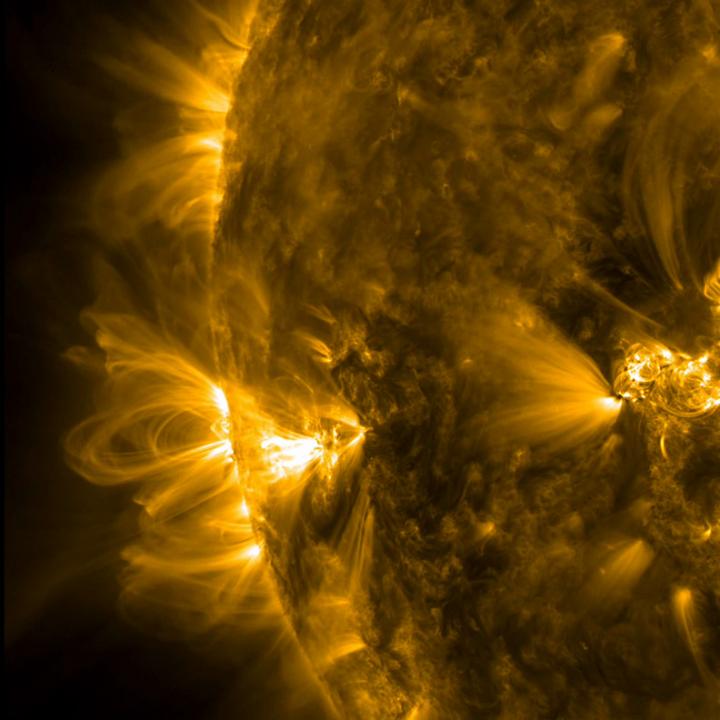PPPL physicists find clue to formation of magnetic fields around stars and galaxies

This is an image of coronal loops on the sun that are linked to magnetic fields. Credit: NASA/Solar Dynamics Observatory
Squire and Bhattacharjee analyzed the behavior of dynamos, which occur when an electrically charged fluid like plasma swirls in a way that creates and then amplifies a magnetic field. Scientists have known that plasma turbulence can create lots of small magnetic fields, but the mechanism by which those fields could produce a single large field is elusive. “We can observe magnetic fields all over the universe,” said Squire. “But we currently lack a sound theoretical explanation for how they are generated.”
The puzzle consists of the seeming unlikelihood of small disturbances coming together to form something large and organized. Throughout nature, order tends to dissolve into chaos, not the other way around. For instance, if you add a glob of milk to coffee, the glob will dissolve into a collection of tendrils and continue to dissipate until the milk has mixed with all of the coffee. Though not impossible, it's highly unlikely that the dissipated milk would spontaneously gather and reform the original glob.
This kind of natural organization occurs occasionally in the natural world, however. When a tornado forms, the myriad disturbances in the atmosphere during a severe storm coalesce into one giant vortex. But the tornado eventually collapses and the order disappears.
Like tornados, the large-scale magnetic fields throughout the universe seem to be produced by lots of small disturbances. But unlike tornadoes, these magnetic fields persist. “Something is holding up the universe's magnetic fields for billions of years,” said Amitava Bhattacharjee, head of PPPL's Theory Department and co-author of the paper. “But how exactly does the universe get these persistent magnetic properties?”
In the paper, Squire and Bhattacharjee show that under certain conditions small magnetic fields — instead of small velocity fields, which have been studied more often — can combine to form one large field. After running computer simulations on a PPPL computer named “Dawson,” the scientists found that small disturbances can combine to form one large disturbance when there is a lot of velocity shear — when two areas of a fluid are moving at different speeds. “We used a variety of computational and analytic methods to approach the problem from a few different angles,” said Squire.
The team first used so-called statistical simulations, which create a kind of average of the behavior of the entire system. “Statistical simulations capture the properties of hundreds of simulations without actually running them all,” said Bhattacharjee. The scientists also used numerical simulations that begin with initial conditions that are allowed to progress in lengthier runs.
“The results indicate that small-scale magnetic fluctuations can create large-scale magnetic fields that persist,” Bhattacharjee said. “But in order to be conclusive about persistence for long times, we must run simulations for very low dissipation,” a measure of energy loss. “It is impossible to run simulations for dissipation as low as those of real astrophysical plasmas, but our analytical and computational results, in the range in which they are done, strongly suggest that such dynamo action is possible.”
These findings might lead to greater understanding of the behavior of many kinds of astronomical phenomena, including the disks of material that form around black holes and the 11-year solar cycle of our own sun. Computer programs cannot yet simulate these vast astronomical phenomena, so learning how to create simplified models that capture the workings of these large turbulent systems would be helpful.
###
PPPL, on Princeton University's Forrestal Campus in Plainsboro, N.J., is devoted to creating new knowledge about the physics of plasmas — ultra-hot, charged gases — and to developing practical solutions for the creation of fusion energy. Results of PPPL research have ranged from a portable nuclear materials detector for anti-terrorist use to universally employed computer codes for analyzing and predicting the outcome of fusion experiments. The Laboratory is managed by the University for the U.S. Department of Energy's Office of Science, which is the largest single supporter of basic research in the physical sciences in the United States, and is working to address some of the most pressing challenges of our time. For more information, please visit science.energy.gov.
Media Contact
All latest news from the category: Physics and Astronomy
This area deals with the fundamental laws and building blocks of nature and how they interact, the properties and the behavior of matter, and research into space and time and their structures.
innovations-report provides in-depth reports and articles on subjects such as astrophysics, laser technologies, nuclear, quantum, particle and solid-state physics, nanotechnologies, planetary research and findings (Mars, Venus) and developments related to the Hubble Telescope.
Newest articles

Innovative vortex beam technology
…unleashes ultra-secure, high-capacity data transmission. Scientists have developed a breakthrough optical technology that could dramatically enhance the capacity and security of data transmission (Fig. 1). By utilizing a new type…

Tiny dancers: Scientists synchronise bacterial motion
Researchers at TU Delft have discovered that E. coli bacteria can synchronise their movements, creating order in seemingly random biological systems. By trapping individual bacteria in micro-engineered circular cavities and…

Primary investigation on ram-rotor detonation engine
Detonation is a supersonic combustion wave, characterized by a shock wave driven by the energy release from closely coupled chemical reactions. It is a typical form of pressure gain combustion,…



